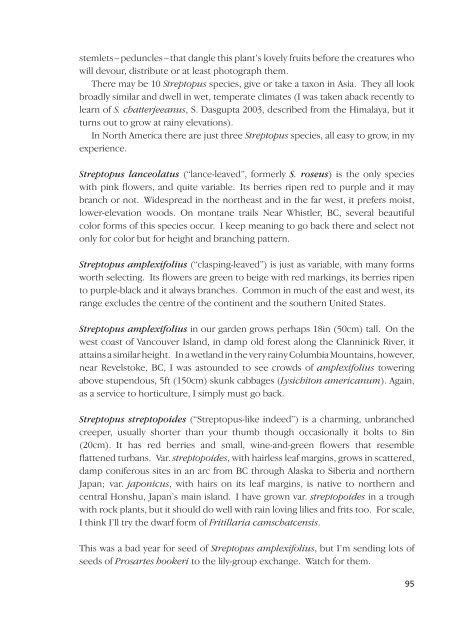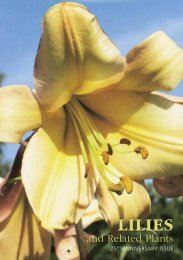Lilies and Related Plants - RHS Lily Group
Lilies and Related Plants - RHS Lily Group
Lilies and Related Plants - RHS Lily Group
You also want an ePaper? Increase the reach of your titles
YUMPU automatically turns print PDFs into web optimized ePapers that Google loves.
stemlets – peduncles – that dangle this plant’s lovely fruits before the creatures who<br />
will devour, distribute or at least photograph them.<br />
There may be 10 Streptopus species, give or take a taxon in Asia. They all look<br />
broadly similar <strong>and</strong> dwell in wet, temperate climates (I was taken aback recently to<br />
learn of S . chatterjeeanus, S. Dasgupta 2003, described from the Himalaya, but it<br />
turns out to grow at rainy elevations).<br />
In North America there are just three Streptopus species, all easy to grow, in my<br />
experience.<br />
Streptopus lanceolatus (“lance-leaved”, formerly S. roseus) is the only species<br />
with pink flowers, <strong>and</strong> quite variable. Its berries ripen red to purple <strong>and</strong> it may<br />
branch or not. Widespread in the northeast <strong>and</strong> in the far west, it prefers moist,<br />
lower-elevation woods. On montane trails Near Whistler, BC, several beautiful<br />
color forms of this species occur. I keep meaning to go back there <strong>and</strong> select not<br />
only for color but for height <strong>and</strong> branching pattern.<br />
Streptopus amplexifolius (“clasping-leaved”) is just as variable, with many forms<br />
worth selecting. Its flowers are green to beige with red markings, its berries ripen<br />
to purple-black <strong>and</strong> it always branches. Common in much of the east <strong>and</strong> west, its<br />
range excludes the centre of the continent <strong>and</strong> the southern United States.<br />
Streptopus amplexifolius in our garden grows perhaps 18in (50cm) tall. On the<br />
west coast of Vancouver Isl<strong>and</strong>, in damp old forest along the Clanninick River, it<br />
attains a similar height. In a wetl<strong>and</strong> in the very rainy Columbia Mountains, however,<br />
near Revelstoke, BC, I was astounded to see crowds of amplexifolius towering<br />
above stupendous, 5ft (150cm) skunk cabbages (Lysichiton americanum). Again,<br />
as a service to horticulture, I simply must go back.<br />
Streptopus streptopoides (“Streptopus-like indeed”) is a charming, unbranched<br />
creeper, usually shorter than your thumb though occasionally it bolts to 8in<br />
(20cm). It has red berries <strong>and</strong> small, wine-<strong>and</strong>-green flowers that resemble<br />
flattened turbans. Var. streptopoides, with hairless leaf margins, grows in scattered,<br />
damp coniferous sites in an arc from BC through Alaska to Siberia <strong>and</strong> northern<br />
Japan; var. japonicus, with hairs on its leaf margins, is native to northern <strong>and</strong><br />
central Honshu, Japan’s main isl<strong>and</strong>. I have grown var. streptopoides in a trough<br />
with rock plants, but it should do well with rain loving lilies <strong>and</strong> frits too. For scale,<br />
I think I’ll try the dwarf form of Fritillaria camschatcensis.<br />
This was a bad year for seed of Streptopus amplexifolius, but I’m sending lots of<br />
seeds of Prosartes hookeri to the lily-group exchange. Watch for them.<br />
95




